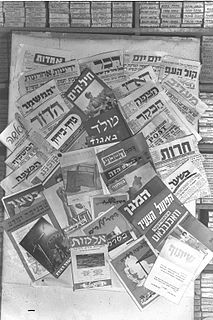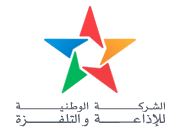Related Research Articles
Sudan has many local and national newspapers. The major national dailies are published in Arabic or English. Sudan Television broadcasts sixty hours of programming a week. The Sudan National Broadcasting Corporation airs radio programming in Arabic, English, French, and Swahili. Radio and television stations are state-controlled entities and serve as outlets for the government viewpoint. Journalists and the papers they serve, although subject to government censorship, operate with more freedom and independence than in most neighboring countries or Arab states. The Voice of Sudan, sponsored by the National Democratic Alliance, broadcasts in Arabic and English. The opposition Sudan People's Liberation Army issues its own newspapers and journals.
Nichane was a Moroccan weekly arabophone and darijophone news magazine.

Ahmed Reda Benchemsi is a Moroccan journalist. He is the founder and was the publisher and editor of Tel Quel and Nichane magazines.
The media of Libya consists of a broad range of newspapers, TV channels, radio stations, and websites mostly set up during or after the Libyan Civil War, which removed previously tight restrictions on freedom of the press and freedom of speech. By the summer of 2012, there were over 200 registered newspapers, over 20 TV channels, and 200 radio stations.

The media of Israel refers to print, broadcast and online media available in the State of Israel. The country boasts dozens of newspapers, magazines, and radio stations, which play an important role by the press in political, social and cultural life and cater it to a modern, developed and literate society.

The Broadcasting and Television National Company is the public broadcaster of Morocco. It was formerly called Moroccan Radio and Television (RTM) from 1956 and Radiodiffusion-Télévision Marocaine (RTM) from 1961. Radio-Maroc was one of the founding members of the European Broadcasting Union in 1950 and continued as an active member until 1 January 1961 when RTM changed its affiliation to associate membership. In 1969 RTM was readmitted as an active member.
The print, broadcast and online media of Burma has undergone strict censorship and regulation since the 1962 Burmese coup d'état. The constitution provides for freedom of speech and the press; however, the government prohibits the exercise of these rights in practice. Reporters Without Borders ranked Burma 174th out of 178 in its 2010 Press Freedom Index, ahead of just Iran, Turkmenistan, North Korea, and Eritrea. In 2015, Burma moved up to 144th place, ahead of many of its ASEAN neighbours such as Singapore, as a result of political changes in the country.
As in many developing countries, radio reaches the widest audience in Haiti. Estimates vary, but more than 300 radio stations are believed to broadcast throughout the country. It's easy now to listen to all Haiti radio online on Haiti Media Live http://haitimedia.live Talk show programs serve as one of the few ways in which ordinary Haitians can speak out about politics and the government. A law passed in 1997 declares the airwaves to be the property of the government, but at least 133 unlicensed radio stations operate freely. In addition, there are 50 community-based stations throughout the country.
The media industry of Iraq includes print, radio, television, and online services. In fact, Iraq became the first Arab country to broadcast from a TV station, in 1954. As of 2005 about 80 radio stations and 25 television stations were broadcasting to Iraq in Arabic, Kurdish, Turkmen, and Neo-Aramaic.
The media of Syria consists primarily of television, radio, Internet, film and print. The national language of Syria is Arabic but some publications and broadcasts are also available in English and French. While television is the most popular medium in Syria, the Internet has become a widely utilized vehicle to disseminate content. Transcending all available media, the government seeks to control what Syrians see by restricting coverage from outside sources. Publications and broadcasts are monitored by members of the government. Syria is ranked as one of the most dangerous places in the world for journalists. There were 28 journalists killed in combat in 2012.
The media of Cameroon includes independent outlets. The nation has only one national newspaper, which is state owned.
Media in Chad is controlled by the government.

Media in the Democratic Republic of the Congo are both nationally and internationally state owned and operated.

Al Aoula, also called TVM is a Moroccan public television channel that serves as the flagship TV network of the Broadcasting and Television National Company, Morocco's state-owned broadcaster. The network broadcasts programming in Arabic, Berber and French. Its headquarters are situated in Rabat.
The Media of South Sudan is underdeveloped compared to many other countries, including fellow East African states like Kenya, Tanzania, and Uganda. Poor transportation infrastructure and entrenched poverty in the country inhibit both the circulation of newspapers, particularly in states located far from the capital of Juba, and the ability of media outlets to maintain regular coverage of the entire country.
The media of Mauritania is undergoing a shift into a freer journalistic environment, while becoming increasingly open to private sector.

Latifa Akherbach is a Moroccan politician and journalist. Between 2007 and 2012, she was Secretary of State for Foreign Affairs in the cabinet of Abbas El Fassi.
Television in Morocco. Terrestrial television viewing was estimated at 20% of total television households in 2011. IPTV is offered by Maroc Telecom. Digital terrestrial television is gradually spreading, with 41 national and foreign channels. The national broadcaster SNRT aims to complete digital switchover by 2015.
The Republic of Vanuatu is an officially trilingual state in the western Pacific, the three national languages being English, French and Bislama. There is a diversity of newspapers, but only one, state-owned television channel. Private radio stations are a recent development; there were reportedly none in 2007.
Media in Namibia includes radio, television, and online and print formats.
References

- ↑ Miller, Susan Gilson. (2013). A history of modern Morocco. New York: Cambridge University Press. p. 84. ISBN 9781139624695. OCLC 855022840.
- 1 2 Miller, Susan Gilson. (2013). A history of modern Morocco. New York: Cambridge University Press. p. 68. ISBN 9781139624695. OCLC 855022840.
- ↑ Source: Media and communication - Gov't of Morocco Archived October 12, 2007, at the Wayback Machine .
- ↑ Morocco Newsline, Karim Zouiyen, Chief Editor.
- ↑ Text used in this cited section originally came from: Morocco profile from the Library of Congress Country Studies project.
- ↑ Moroccan Prime Minister bans weekly magazine “Nichane” [ dead link ]
- ↑ Advances and reverses for press freedom during King Mohammed’s first decade Reporters Without Borders, 22.07.2009
- ↑ "2019 World Press Freedom Index". Reporters Without Borders . Archived from the original on April 24, 2019. Retrieved 3 May 2019.